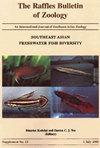印度尼西亚北加里曼丹省婆罗洲象的食物偏好及其保护意义
IF 1
4区 生物学
Q2 ZOOLOGY
引用次数: 0
摘要
对特定植物物种的偏好可能反映了动物感知到的最理想的成分,与可用的成分有关。通过对几种已知食用植物代谢物的化学分析,研究了北加里曼丹Sebuku地区婆罗洲象(Elephas maximus borneensis Deraniyagala, 1950)的食物偏好。我们从13种食性植物物种中分析了婆罗洲象食物的化学性质,这些物种代表了研究区域婆罗洲象利用的食性植物类别的水平。对所有样品进行营养价值分析,并使用1h核磁共振波谱获得其代谢谱。对这些数据进行多变量数据分析,以确定共同成分。这项研究证实,婆罗洲象倾向于遵循一种策略,通过选择富含糖和粗蛋白质的食物来最大化他们的能量摄入,并尽量减少纤维元素。事实上,它们也更喜欢谷氨酸含量高的食物,这表明味道起了作用,这一元素可能是婆罗洲象协助觅食和寻找美味食物的线索。本文章由计算机程序翻译,如有差异,请以英文原文为准。
Food preference of the bornean elephant (Elephas maximus borneensis) in North Kalimantan Province, Indonesia, and its conservation implications
The preference to feed on particular plant species may reflect the most desirable components that an animal perceives, in relation to what is available. The food preference of the Bornean elephant (Elephas maximus borneensis Deraniyagala, 1950) in the Sebuku area of North Kalimantan was studied by chemical analysis on the metabolites of several known food plant species. We analysed the chemical properties of the Bornean elephant diet from thirteen food-plant species which represented the level of food-plant categories utilised by the Bornean elephant in the study area. All samples were analysed for nutritional value, and their metabolic profiles were obtained using 1 H nuclear magnetic resonance spectroscopy. These data were subjected to multivariate data analyses to identify the common components. This study confirmed that Bornean elephants tend to follow a strategy to maximise their energy intake by selecting food items rich in sugar and crude protein and minimise fibrous elements. The fact that they also prefer food items with high glutamate suggests that taste plays a role and this element may be a cue for the Bornean elephant to assist in foraging and searching for palatable food.
求助全文
通过发布文献求助,成功后即可免费获取论文全文。
去求助
来源期刊

Raffles Bulletin of Zoology
生物-动物学
CiteScore
2.10
自引率
18.20%
发文量
0
审稿时长
6-12 weeks
期刊介绍:
The Raffles Bulletin of Zoology (RBZ) is a peer-reviewed journal, which publishes high quality papers in Taxonomy, Ecology and Conservation Biology of animals from Southeast Asia and its adjacent areas.
The journal aims to build up quality information on the “animal diversity” of Southeast Asia in particular. The journal will also publish papers from outside the stated geographic range that deal with material deposited in the Zoological Reference Collection (ZRC) of the Lee Kong Chian Natural History Museum (LKCNHM), National University of Singapore. Both descriptive and experimental papers will be considered. Similarly, both single species (except for insect taxa) and ecosystem studies will be considered for publication. Single species descriptions for insect taxa are not accepted except under strong recommendations from Editors. Manuscripts that are checklists or based on new records will no longer be accepted unless they are of significant scientific value.
 求助内容:
求助内容: 应助结果提醒方式:
应助结果提醒方式:


